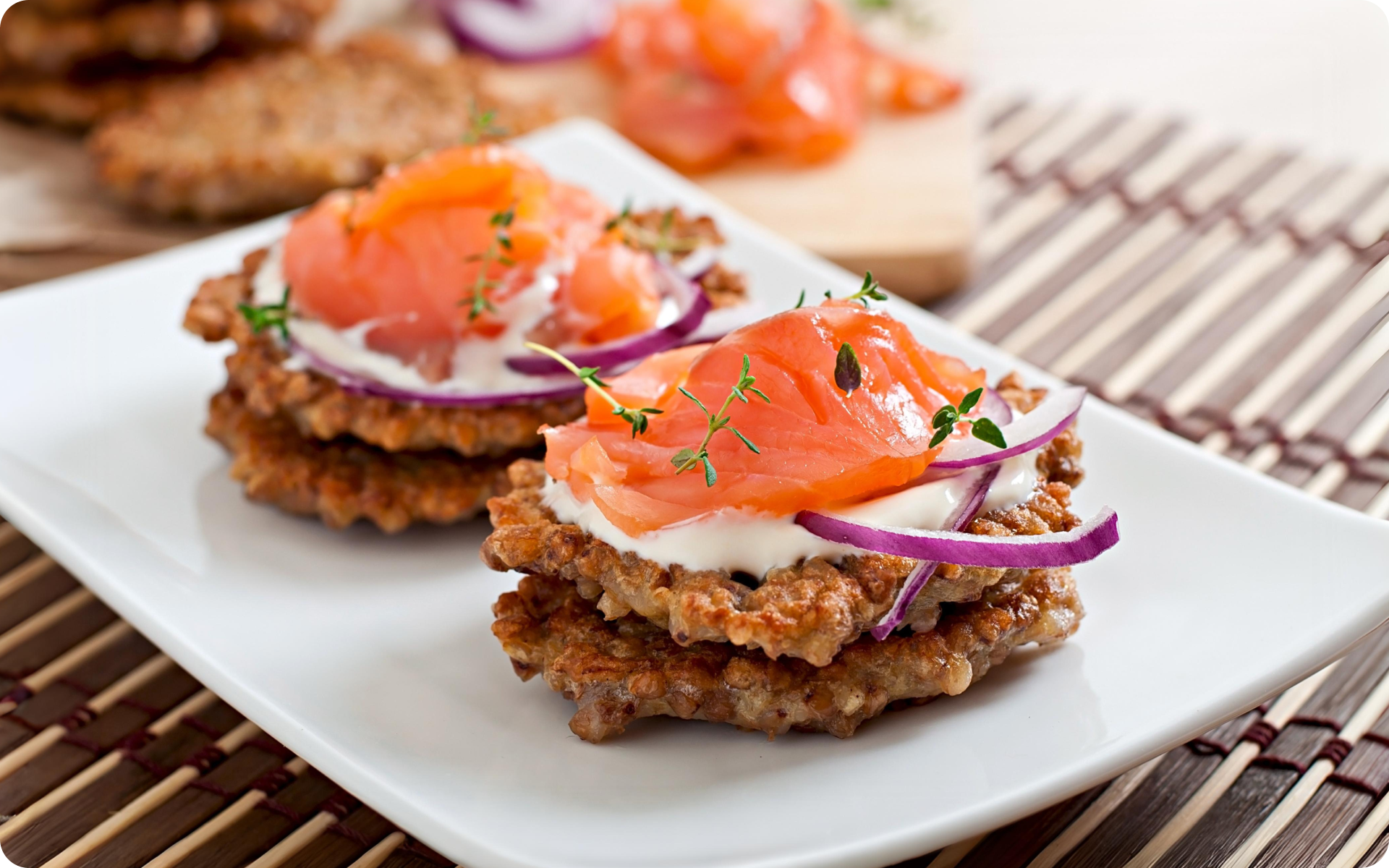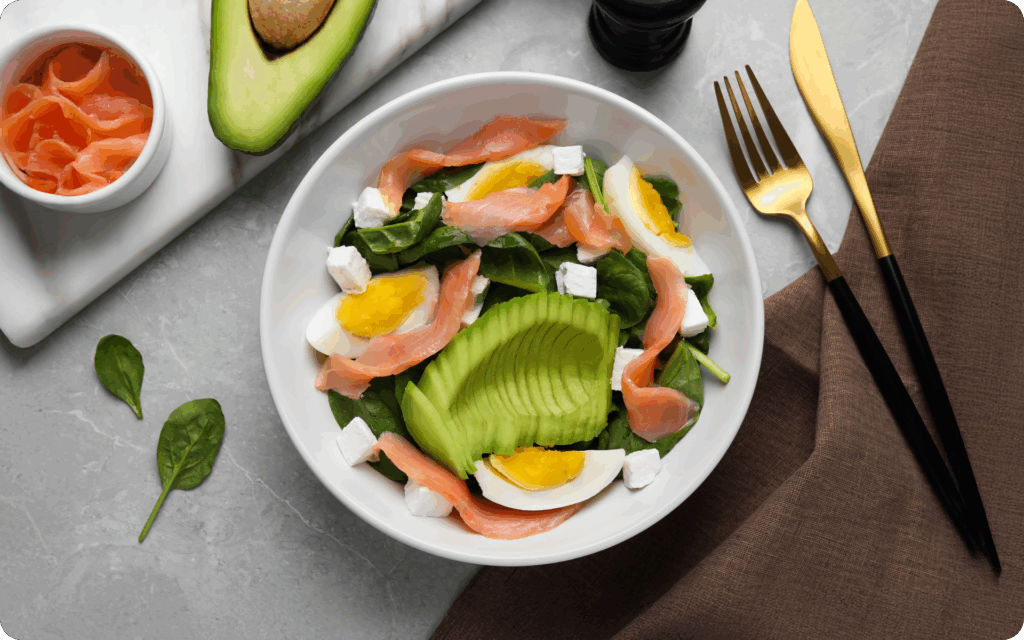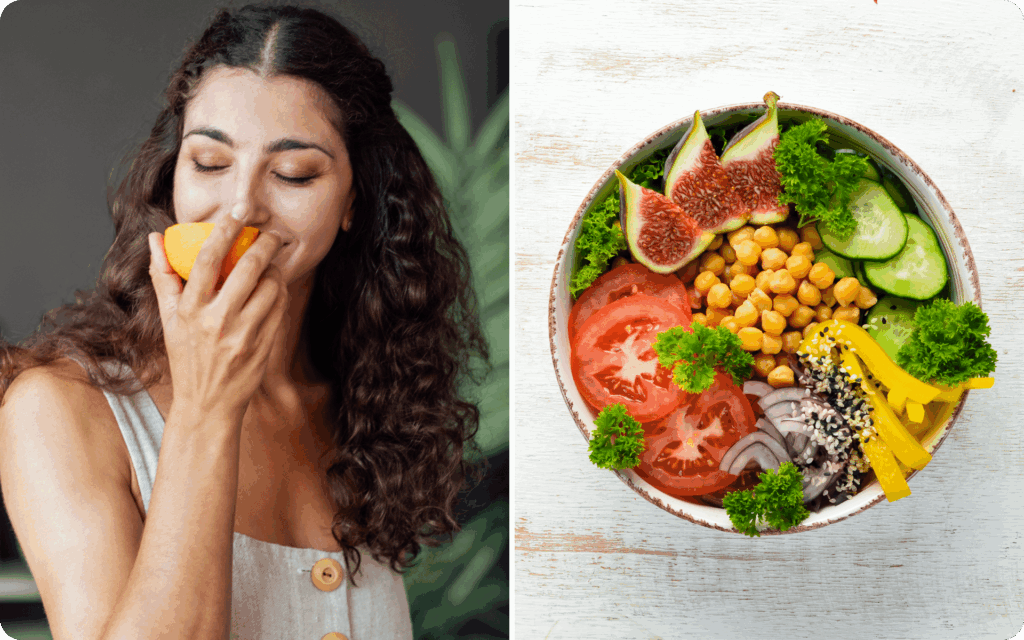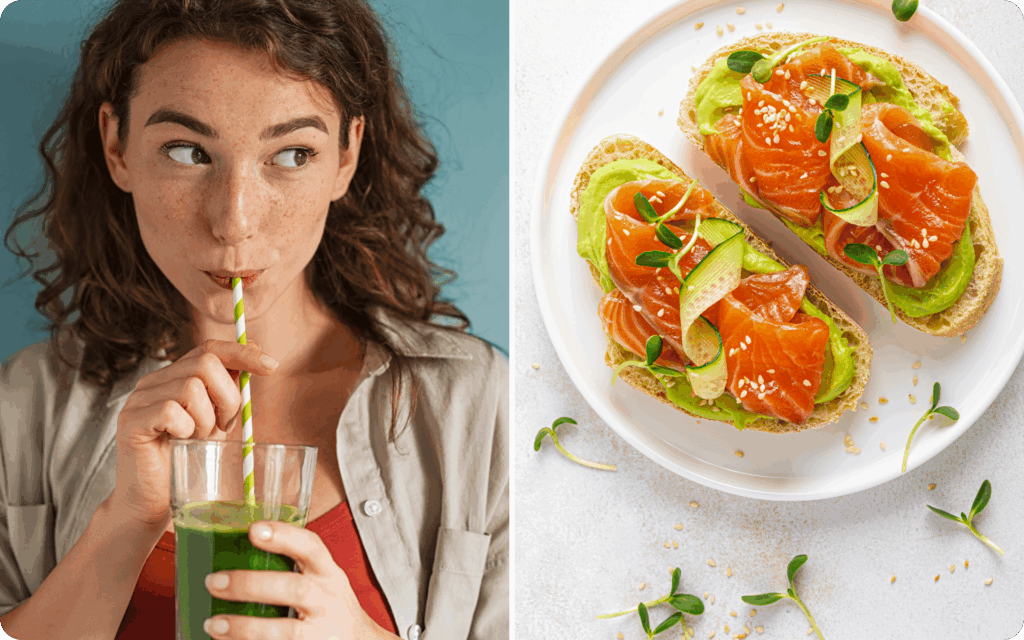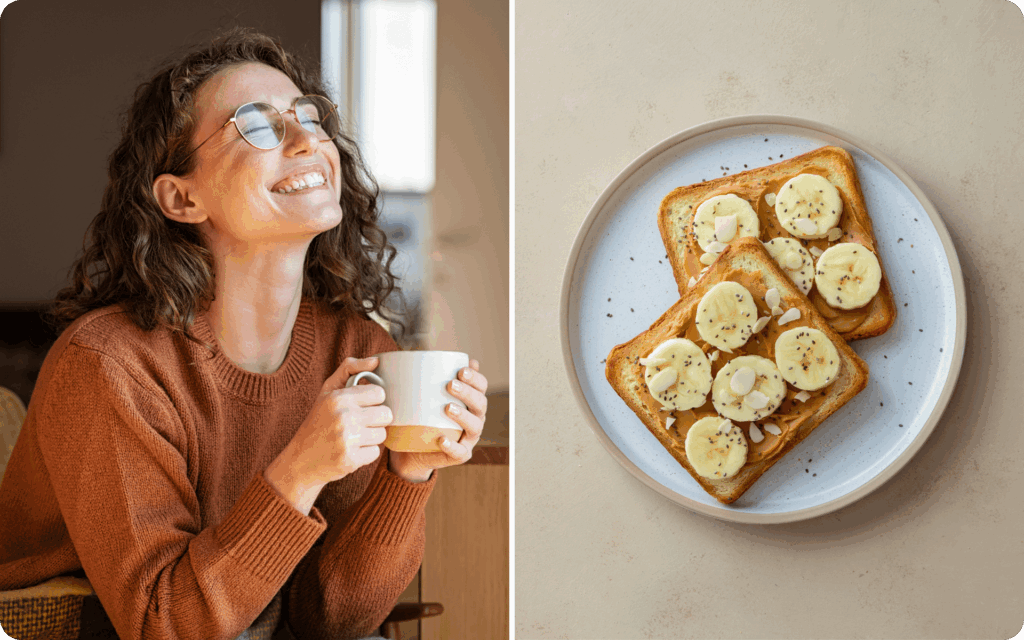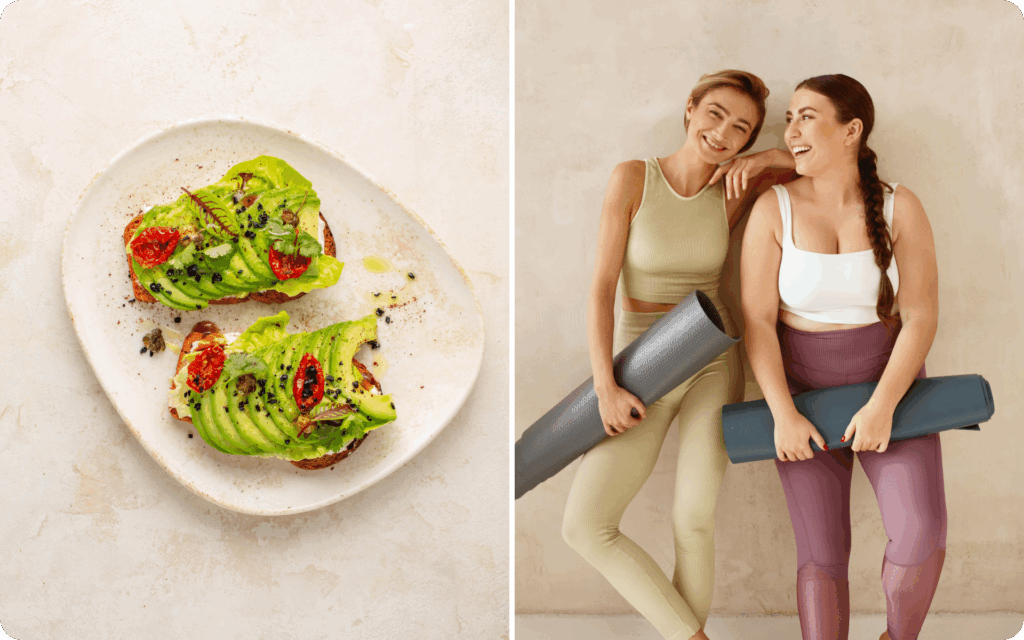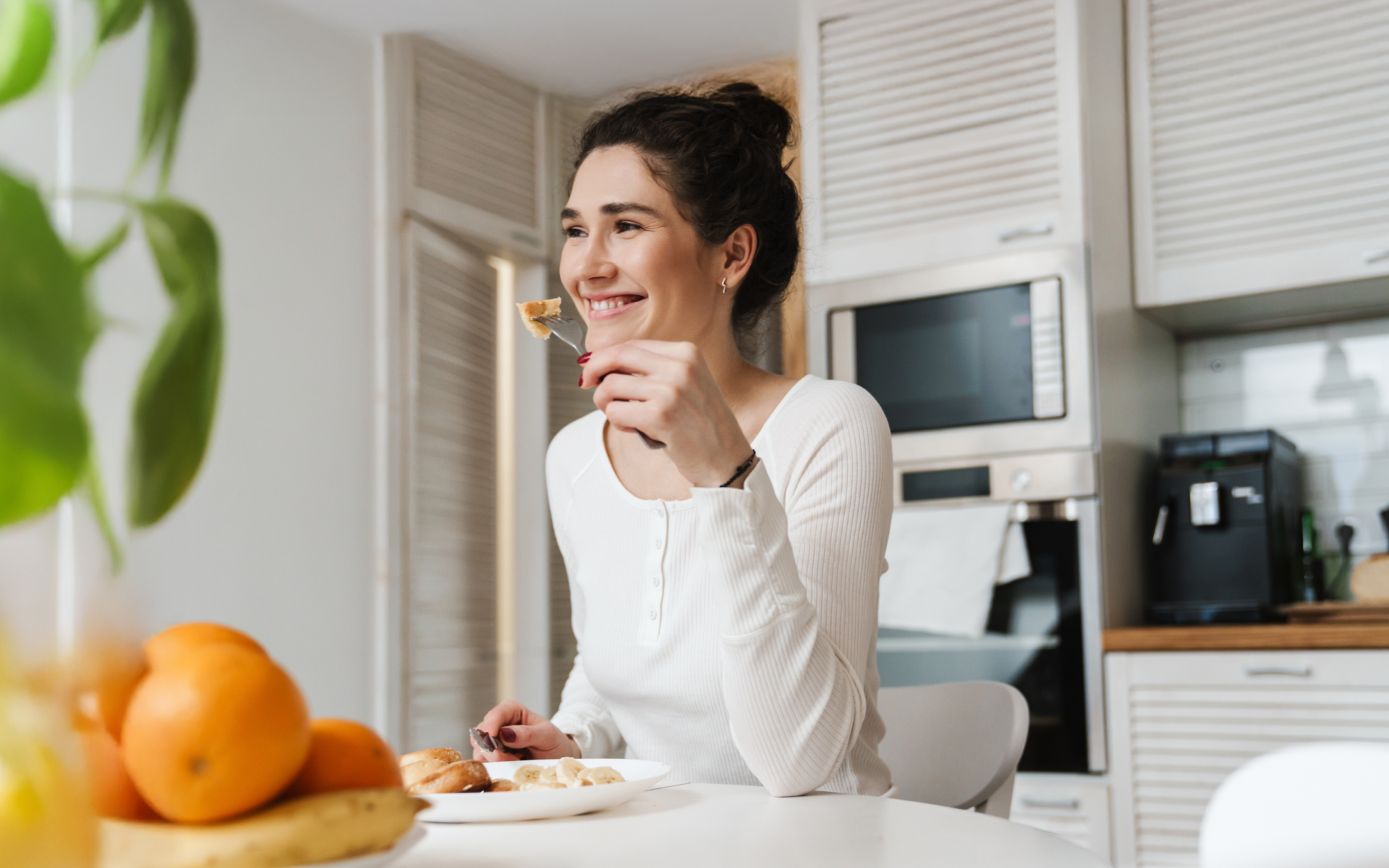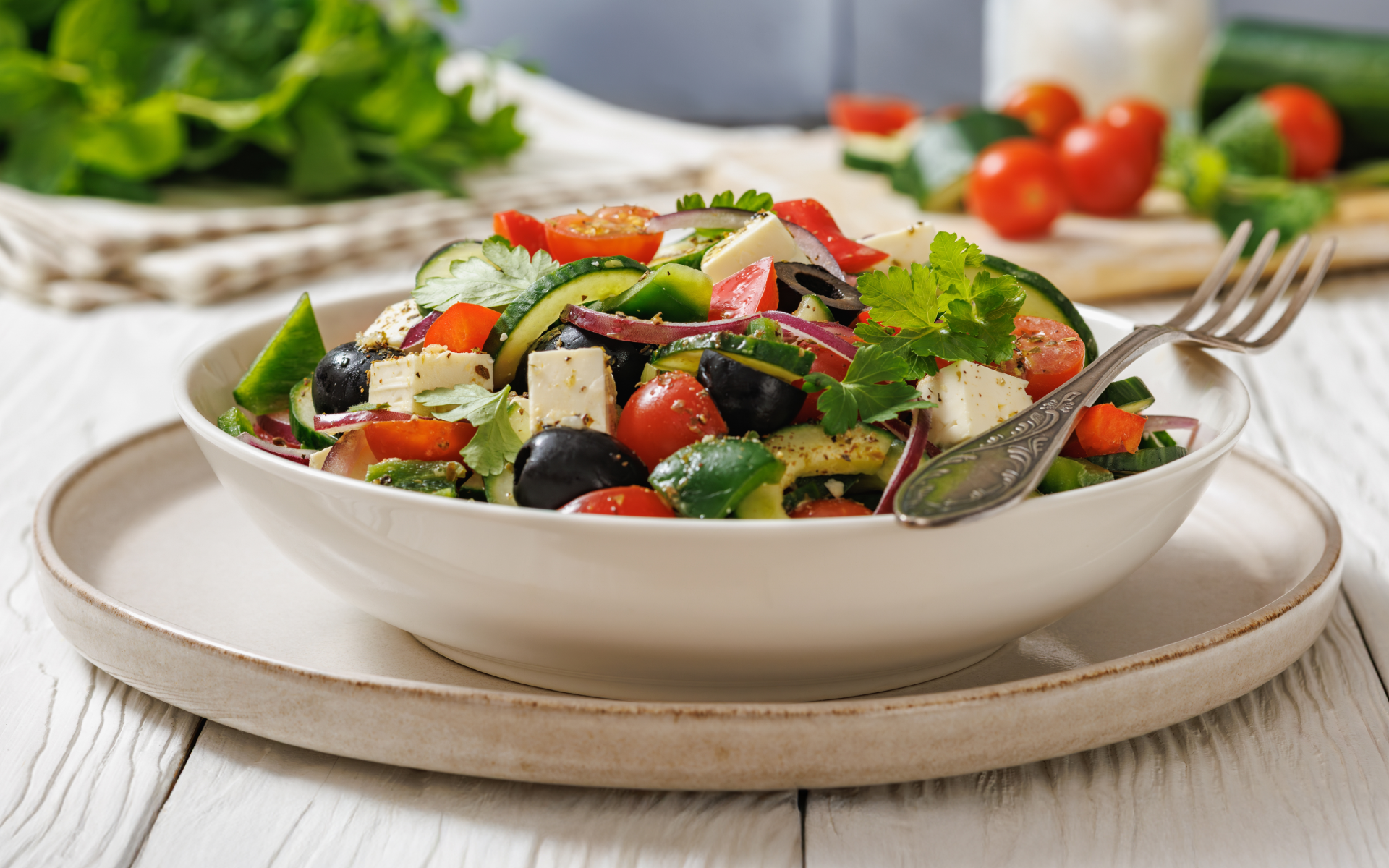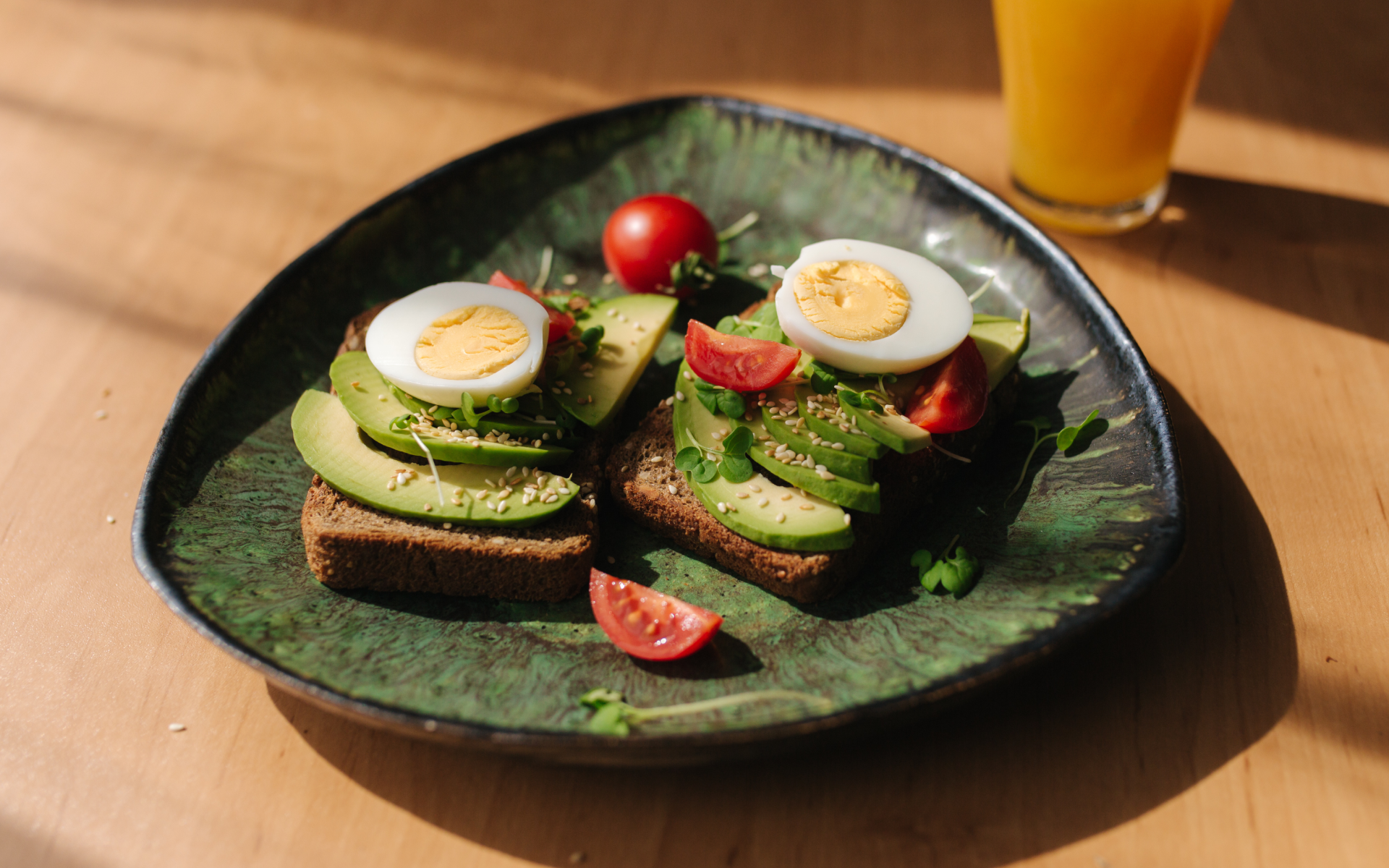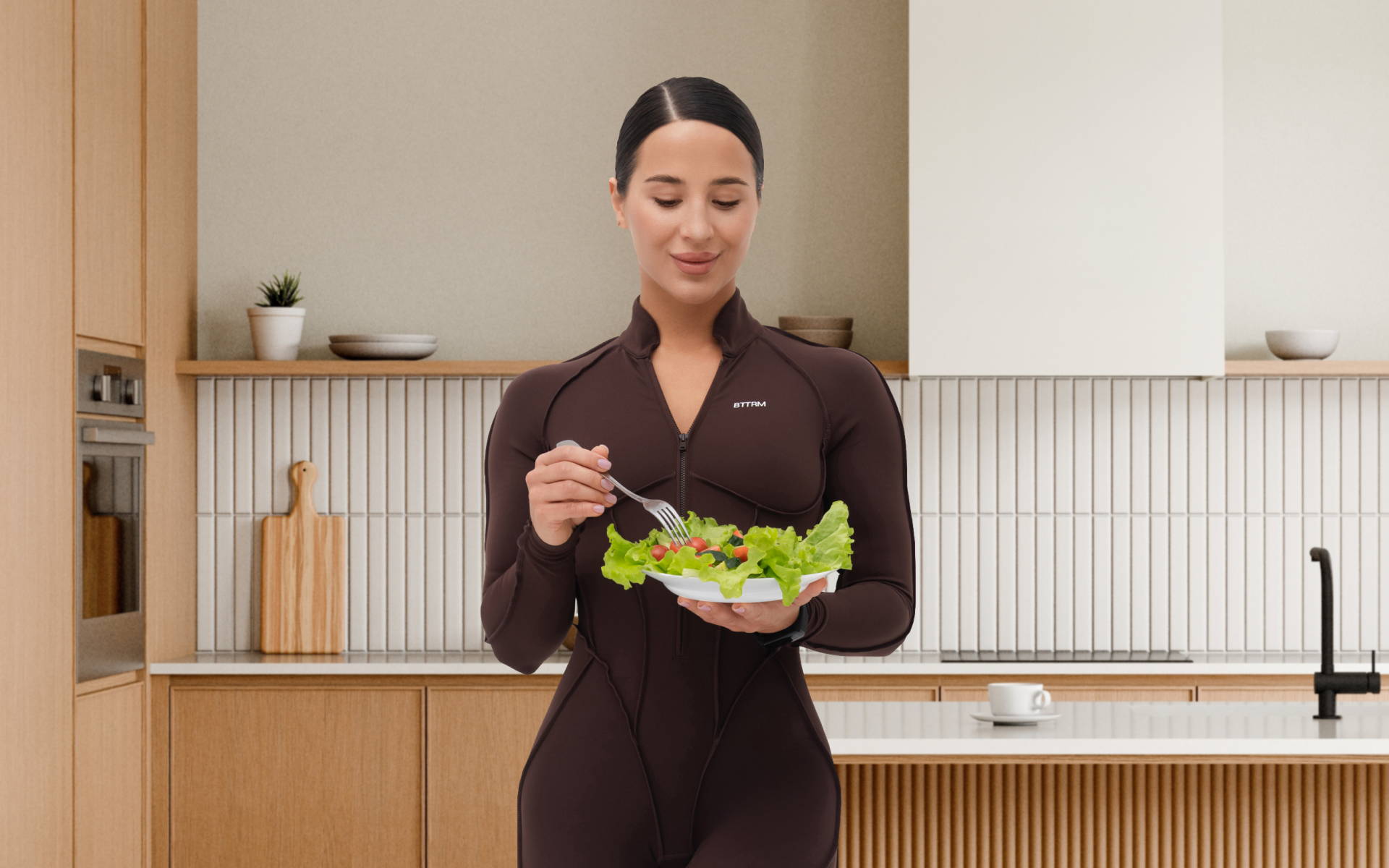At its core, the keto diet is a low-carbohydrate, high-fat eating plan designed to shift the body into a metabolic state called ketosis. In ketosis, the body primarily burns fat for energy instead of carbohydrates, which, according to most experts, has a range of potential benefits for some individuals (1).
A significant feature of the keto diet is its emphasis on minimizing carbohydrates, often to just 20-50 grams per day (2).
For comparison, traditional diets in the U.S. typically include around 300 grams of carbs daily. Restricting carbs to such a low level requires purposeful meal planning and a clear understanding of which foods to embrace and which to limit.
So, what is a strict 50 grams of carbs per day meal plan?
If you’re curious about how to structure meals within this framework, you’re in the right place. Read on for a practical, easy-to-follow meal plan designed to stay within the 50-gram carb limit.
Is 50 Grams Of Carbs Still Keto?
When considering if 50 grams of carbohydrates per day “counts” as part of a ketogenic diet, the answer isn’t a simple yes or no.
The essence of a keto diet lies not in the exact carb grams consumed, but in achieving and maintaining a metabolic state called ketosis. Ketosis occurs when your body shifts from using carbohydrates as its primary energy source to relying primarily on fat, which it converts into ketones, for fuel (3).
For some individuals, 50 grams of carbs per day is still low enough to promote ketosis. However, whether that level works for you depends on several factors, including your activity level, metabolic health, and macronutrient balance.
What Makes A Diet Ketogenic?
At its core, a ketogenic diet is:
- High in fat
- Moderate in protein
- Very low in carbohydrates.
But here’s the key: the primary goal is to limit carbs enough that your body has to turn to fat for energy, producing ketones in the process (2, 3). It’s not about hitting a universal “magic number” for carb intake; it’s about achieving a physiological shift.
Highly active people, particularly those engaging in high-intensity exercise, may be able to consume closer to 50 grams of carbs daily and still stay in ketosis.
Similarly, if your body is already metabolically flexible (e.g., efficient at switching between burning carbs and fat), you may tolerate slightly more carbs. On the other hand, those with insulin resistance or a sedentary lifestyle may need to aim closer to 20 or 30 grams of carbs (or even less) to maintain ketosis.
BetterMe: Health Coaching app helps you achieve your body goals with ease and efficiency by helping to choose proper meal plans and effective workouts. Start using our app and you will see good results in a short time.
How To Know If You’re In Ketosis
The best way to determine if your diet is ketogenic isn’t by counting carbs alone but by monitoring ketosis. There are tools like ketone test strips (for urine) or blood ketone meters that give you a more accurate picture of whether your body is producing ketones.
Beyond testing, you may notice signs like (4):
- Reduced hunger: Many people in ketosis report feeling less hungry between meals.
- Steady energy: Without the energy dips associated with blood sugar spikes and crashes, you might feel more balanced and sustained throughout the day.
- Mental clarity: Some followers report a heightened sense of focus or clear-headedness, although this is a subjective experience and not a universal one.
Read more: Super Simple Healthy Meal Plan with Grocery List for Beginners
Will I Lose Weight If I Eat 50g Carbs A Day?
Keto can be a helpful tool for weight management through several mechanisms:
- Fat Burning: By limiting carbs, your body becomes more efficient at burning stored fat for energy. This bodily focus on burning fat can lead to fat loss over time, especially if you’re in a calorie deficit (consuming fewer calories than your body burns) (1).
- Water Weight Loss: At the beginning of a low-carb diet, you’ll likely notice rapid weight loss (4). This isn’t fat; it’s water. Carbohydrates are stored in your body alongside water, and when those stores are depleted, a significant amount of water weight is lost (5).
- Reduced Appetite: Ketosis has been shown to help regulate hormones that affect hunger, such as ghrelin (the hormone that stimulates hunger) and leptin (the hormone that signals fullness) (6). Many people on the keto diet report feeling more satisfied for longer, which helps reduce overall calorie intake naturally. However, individual experiences may vary.
- Steady Blood Sugar Levels: By minimizing carb intake, you avoid the blood sugar spikes and crashes that often accompany high-carb meals (7). Stable energy can help reduce cravings and overeating. However, blood sugar fluctuations after meals are normal and not a concern in healthy individuals.
While keto offers potential benefits for weight loss, outcomes are highly individual.
Whether you lose weight, and how much of it you lose, is influenced by:
- Calorie Intake: No matter how low your carb intake, you won’t lose weight if you’re consuming more calories than your body burns (8). Keto helps some people naturally eat fewer calories due to reduced hunger; however, portion control and mindful eating remain important.
- Macronutrient Balance: The keto diet is not just low-carb, it’s also high-fat and moderate in protein. Eating too much protein or not enough fat can interfere with achieving and maintaining ketosis, because excess protein can be converted into glucose for energy.
- Metabolic Health: Your body composition, insulin sensitivity, and other aspects of your metabolic health can determine how effective keto is for you.
- Activity Level: Regular exercise can enhance weight loss by increasing calorie burn and improving metabolic flexibility, enabling your body to utilize fat for fuel more effectively.
What Can I Eat For 50g Carbs?
Below are some food categories to consider for a 1-week keto meal plan or any keto meal plan duration, along with specific examples to help you build a diverse and enjoyable menu.
1. Non-Starchy Vegetables
Non-starchy vegetables are a staple on the keto diet. They’re packed with essential vitamins, minerals, and fiber while being naturally low in carbs (9). Incorporate a variety of these to keep your meals colorful and nutrient-rich.
Examples include:
- Kale
- Spinach
- Zucchini
- Broccoli
- Cauliflower
- Bell peppers
- Cucumber
- Mushrooms
- Brussels sprouts
2. Healthy Fats
Fats take center stage in a ketogenic diet, providing the majority of your daily calories.
Including a range of healthy fat sources can help keep you full and satisfied (10).
Here are some keto-friendly fat sources:
- Avocados
- Olive oil
- Coconut oil in moderation
- Fatty fish like salmon, mackerel, and sardines
- Nuts like walnuts, macadamia nuts, and pecans
- Seeds like chia seeds, flaxseeds, and sunflower seeds
- Other vegetable oils like canola, avocado, grapeseed, and more
- Butter or ghee (from grass-fed sources, if possible) in moderation
3. Protein-Rich Foods
While the keto diet is not typically high in protein, moderate protein intake is essential for maintaining muscle mass and overall health (11).
Opt for high-quality protein sources, such as:
- Eggs
- Turkey
- Chicken
- Beef (ground, steak, or roast)
- Fish like tuna, cod, salmon, and trout
- Shellfish like shrimp, scallops, and crab
- Pork (chops and roasts, uncured bacon or sausage without added sugar)
4. Fermented Foods
Fermented foods play a significant role in supporting gut health, which is crucial for overall well-being (12).
On a ketogenic diet, these probiotics are an excellent addition:
- Kimchi
- Sauerkraut (without added sugar)
- Pickles (look for unsweetened varieties)
- Full-fat unsweetened Greek yogurt
- Kefir made from whole milk
5. Low-Glycemic Fruits
Most keto practitioners will limit fruit due to its natural sugar content, but you can enjoy low-glycemic fruits in moderation.
These low-glycemic fruits are nutrient-dense and make great snacks or toppings:
- Berries (strawberries, raspberries, blackberries, and blueberries)
- Lemons and limes (great for flavoring water or recipes)
- Small portions of tomatoes and avocado (technically, fruits)
6. Keto-Friendly Snacks
Snacking can be part of a 7 day low-carb meal plan or a 30-day low carb meal plan when done mindfully. Keto-friendly snacks are an opportunity to fuel up without exceeding your carb limit.
Consider these easy options:
- Nut butter (choose varieties without added sugar)
- Cheese slices or cubes
- Seaweed sheets
- Hard-boiled eggs
- Pork rinds
- Olives
7. Baking And Cooking Staples
For those who enjoy baking or cooking, having the right staples on hand can help you create low-carb versions of your favorite dishes.
These options are keto-approved:
- Almond flour
- Coconut flour
- Cream cheese
- Heavy cream
- Unsweetened cocoa powder
- Sugar-free sweeteners like stevia or erythritol
What Do 50g Carbs Look Like?
How much is 50 grams of carbs? If you’re trying to limit yourself to 50 grams of carbohydrates per day, you may be wondering what that actually means in terms of food.
The truth is, 50 grams of carbs can look very different depending on the types of foods you choose to eat. A day’s worth of carbs could fit into small portions of higher-carb options, or it could be spread out across a variety of low-carb, nutrient-dense foods. To learn more about the low-carb meals for family, check out our in-depth article on the topic.
Below, we’ll break this down into practical examples to help you visualize your options and stay on track.
Low-Carb, Nutrient-Dense Foods
Focusing on nutrient-dense, low-carb foods can help you make better use of those 50 grams.
Here are some examples of foods and their approximate carb counts:
Non-Starchy Vegetables (per cup):
- Spinach (raw): 1 gram
- Cauliflower (raw, chopped): 5 grams
- Zucchini (sliced, cooked): 3 grams
- Bell Peppers (sliced): 6 grams
Nuts and Seeds (per ounce):
- Almonds (about 23 nuts): 6 grams
- Sunflower Seeds (shelled): 4 grams
- Chia Seeds (2 tablespoons): 12 grams (but with 10 grams of fiber, net carbs = 2 grams)
Berries (per ½ cup):
- Strawberries (sliced): 6 grams
- Blueberries: 9 grams
- Raspberries: 7 grams (with 4 grams of fiber, net carbs = 3 grams)
How Quickly Carbs Add Up
While low-carb foods make it easier to stay within limits, it’s also helpful to see how higher-carb foods can use up your daily allocation very quickly:
- One Medium Banana: 27 grams
- One Slice of White Bread: 14 grams
- One Medium Apple: 25 grams
Including just one of these higher-carb foods could take up over half (or more) of your daily carb allowance!
What Is An Example Of A 50 Grams Of Carbs Per Day Meal Plan?
Here’s a 50 grams of carbs example of how your meals might look when aiming for a 50 grams of carbs a day meal plan:
Breakfast:
- Scrambled eggs cooked in olive oil with sautéed spinach (1 gram)
- ¼ avocado (2 grams)
- Side of ½ cup of raspberries (3 grams)
Approx. Total = 6 grams
Lunch:
- Grilled chicken salad with mixed greens (1 gram)
- Sliced cucumbers (1 gram)
- Olive oil
- Lemon dressing
- Add ¼ cup of sunflower seeds (3 grams)
Approx. Total = 5 grams
When it comes to weight loss, progress is made by inches, not miles, so it’s much harder to track and a lot easier to give up. The BetterMe: Health Coaching app is your personal trainer, nutritionist, and support system all in one. Start using our app to stay on track and hold yourself accountable!
Snack:
- A handful of almonds (1 ounce, 6 grams)
- 10 black olives (1 gram)
Approx. Total = 7 grams
Dinner:
- Salmon fillet with roasted asparagus (4 spears, 3 grams)
- ½ cup of roasted Brussels sprouts (6 grams)
- Side of cauliflower rice (1 cup, 5 grams)
Approx. Total = 14 grams
Dessert/Treat:
- ¼ cup of blueberries (4 grams) mixed with 2 tablespoons of unsweetened coconut flakes (1 gram).
Approx. Total = 5 grams
Full-Day Carb Total = 37 grams net carbs (including fiber, closer to 50 grams total carbs)
Read more: Elimination Diet Meal Plan: A Comprehensive Guide
What Is The Best Carb For Losing Weight?
Fiber is a key player in weight loss. It helps you feel full longer, reduces the chances of overeating, and supports healthy digestion (13). The best carbohydrate sources for weight loss are those that are high in fiber and packed with nutrients.
These include foods like fruits, vegetables, legumes, and whole grains.
Not only do these food groups offer sustained energy, but they also contain essential vitamins, minerals, and antioxidants that support your body’s overall well-being.
What Happens After 2 Weeks Of 50g Carbs Diets?
While every individual’s experience varies, there are some typical physiological changes that many people notice during this time. These changes reflect your body adapting to a lower-carb intake, and they can range from shifts in energy levels to adjustments in appetite.
Here’s a closer look at what might be happening after 2 weeks on a low-carb diet:
- Entering Ketosis
One primary goal of reducing carb intake to 50 grams per day is to encourage your body to enter ketosis. This metabolic state occurs when limited carbohydrate intake forces your body to switch its primary fuel source from glucose (derived from carbohydrates) to fat. During this process, your liver starts producing ketones from fat, which become your body’s new energy source (3).
By week two, many people are fully transitioning into ketosis, though the timeline can vary based on factors like your previous diet, activity level, and overall metabolic health.
Being in ketosis may come with noticeable shifts, including fewer energy crashes and more stable focus, as your body adapts to burning fat for fuel (4).
- Water Weight Loss
It’s common to experience noticeable weight loss in the first couple of weeks on a low-carb diet.
However, much of this initial weight loss is water weight rather than fat.
Here’s why this happens:
Your body stores carbohydrates in your muscles and liver as glycogen, and glycogen binds to water. When you reduce your carb intake and your glycogen stores deplete, your body releases the extra water (5). While this can be motivating on the scale, it’s also a reminder to stay hydrated, as increased water loss may lead to dehydration if fluid intake isn’t sufficient.
- Appetite Regulation
By the second week, many people report a reduction in appetite. This is partly due to the effects of ketones, which are believed to help suppress hunger hormones, such as ghrelin (6).
Additionally, eating more fats and proteins (key components of a low-carb diet) tends to be more satiating than high-carb meals.
Reducing hunger by consuming more fats and proteins can make it easier to eat fewer overall calories while enjoying 50 grams of carbs calories as well. This calorie reduction can potentially support weight loss (1).
- Energy Levels (A Mixed Bag)
Energy changes during this period can vary. Some people report feeling more energetic and free from the high highs and low lows associated with blood sugar spikes.
Others, especially if they’re new to a low-carb lifestyle, may still be adjusting and experience periods of fatigue or what’s often referred to as the “keto flu.”
This temporary phase can occur as your body adapts to using fat instead of carbohydrates for energy and is often accompanied by symptoms such as headaches or irritability (4).
To combat this, ensure your diet includes adequate hydration and electrolytes, such as sodium, magnesium, and potassium, which are often depleted due to increased water loss.
- Personal Variability Matters
It’s important to remember that not everyone will experience these changes in the same way. Factors like your level of physical activity, current health conditions, and how strictly you adhere to the diet can all influence your results.
Some individuals may feel fantastic by the second week, motivated by less hunger and more stable energy, while others might notice their body still adjusting.
What To Watch For In Future Weeks
By the second week, you’re likely laying the groundwork for changes that will continue to unfold over the next month and beyond.
Many people start to notice improved metabolic flexibility, fat loss, or even mental clarity during this phase, paving the way for more lasting results. Conversely, it’s essential to listen to your body and adjust as needed, especially if fatigue or other symptoms persist. Consult your healthcare provider if you have any concerns or questions.
For some individuals, reducing or eliminating carbs can lead to more stable blood sugar levels, thereby avoiding the spikes and crashes that certain high-carb foods can cause. Although these fluctuations are normal and not a concern in healthy people (7), they can be problematic for those with certain health conditions. Additionally, the body may adapt to using fat as a primary energy source, which some individuals report makes them feel more focused and energized. This experience can vary widely, though, and others may initially feel fatigued as their body adjusts to a low-carb diet. Yes, rice is considered a high-carbohydrate food. For example, one cup of cooked white rice contains around 45 grams of carbs (14), while one cup of cooked brown rice has approximately 50 grams (15). These amounts can take up most or all of your daily carb allowance if you’re following a low-carb or ketogenic diet, but are a reasonable serving size for those on a balanced diet. If you significantly reduce or eliminate carbs for a week, your body may initially start to deplete its glycogen stores, leading to water weight loss. You could also experience a reduction in appetite due to fewer fluctuations in blood sugar. Some individuals may experience symptoms of the “keto flu,” such as fatigue, headaches, or irritability, as their body adapts to burning fat for fuel. Individual responses vary widely based on factors like metabolic health and activity level (4). Completely carb-free foods are rare. Typically, animal-based options include eggs, fatty fish (such as salmon and mackerel), specific cuts of meat (beef, pork, and chicken), and butter, which have minimal carbohydrates. Oils such as olive oil, coconut oil, and avocado oil also fall into this category. It’s worth noting that most plant-based foods, even low-carb vegetables, contain trace amounts of carbohydrates.Frequently Asked Questions
Why do I feel better when I don’t eat carbs?
Is rice high in carbs?
What happens if you quit carbs for 7 days?
What foods are zero carb?
The Bottom Line
Building a meal plan for 50 grams of carbs per day doesn’t mean your food choices have to feel “strict” or restrictive. From nutrient-dense vegetables and healthy fats to protein-rich staples and keto-friendly snacks, there’s a wide variety of options to enjoy.
By experimenting with these food categories, you can create meals that are both delicious and aligned with your dietary goals.
DISCLAIMER:
This article is intended for general informational purposes only and does not serve to address individual circumstances. It is not a substitute for professional advice or help and should not be relied on for making any kind of decision-making. Any action taken as a direct or indirect result of the information in this article is entirely at your own risk and is your sole responsibility.
BetterMe, its content staff, and its medical advisors accept no responsibility for inaccuracies, errors, misstatements, inconsistencies, or omissions and specifically disclaim any liability, loss or risk, personal, professional or otherwise, which may be incurred as a consequence, directly or indirectly, of the use and/or application of any content.
You should always seek the advice of your physician or other qualified health provider with any questions you may have regarding a medical condition or your specific situation. Never disregard professional medical advice or delay seeking it because of BetterMe content. If you suspect or think you may have a medical emergency, call your doctor.
SOURCES:
- Nutritional Ketosis for Weight Management and Reversal of Metabolic Syndrome (2018, link.springer.com)
- Ketogenic Diet (2023, ncbi.nlm.nih.gov)
- Biochemistry, Ketogenesis (2023, ncbi.nlm.nih.gov)
- Symptoms during initiation of a ketogenic diet: a scoping review of occurrence rates, mechanisms, and relief strategies (2025, frontiersin.org)
- Glycogen storage: illusions of easy weight loss, excessive weight regain, and distortions in estimates of body composition (1992, sciencedirect.com)
- Impact of ketosis on appetite regulation—a review (2020, sciencedirect.com)
- Carbohydrates and Blood Sugar (n.d., nutritionsource.hsph.harvard.edu)
- Fat Loss Depends on Energy Deficit Only, Independently of the Method for Weight Loss (2007, karger.com)
- Associations of starchy and non-starchy vegetables with risk of metabolic syndrome: evidence from the NHANES 1999–2018 (2023, nutritionandmetabolism.biomedcentral.com)
- Fats and Satiety (2010, ncbi.nlm.nih.gov)
- Protein power essential for building and maintaining muscle mass (2025, news-medical.net)
- Fermented Foods, Health and the Gut Microbiome (2022, mdpi.com)
- Increased dietary fiber is associated with weight loss among Full Plate Living program participants (2023, frontiersin.org)
- Rice, white, long-grain, regular, unenriched, cooked without salt (2019, fdc.nal.usda.gov)
- Rice, brown, long-grain, cooked (Includes foods for USDA’s Food Distribution Program) (2019, fdc.nal.usda.gov)
